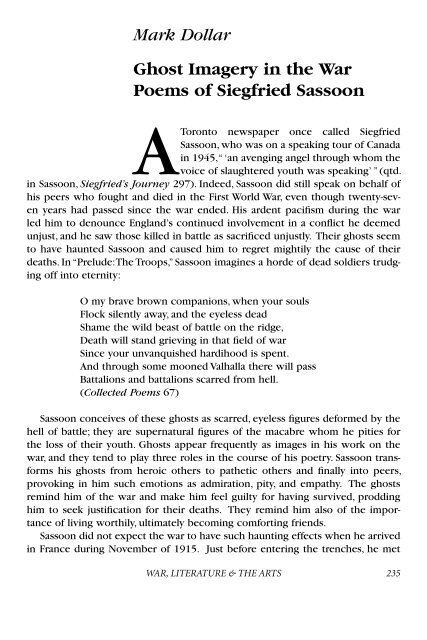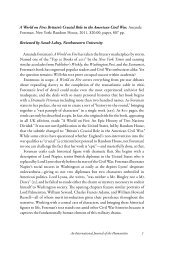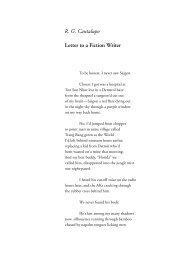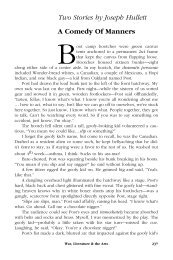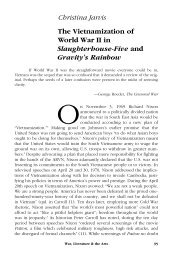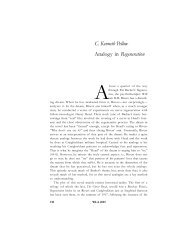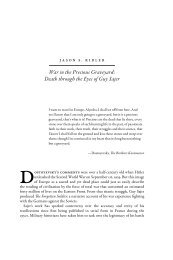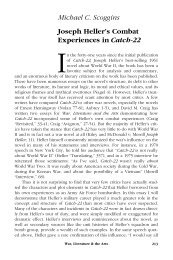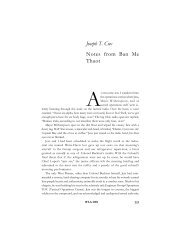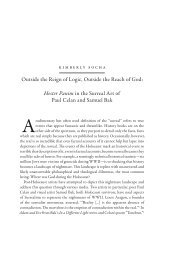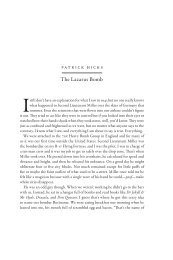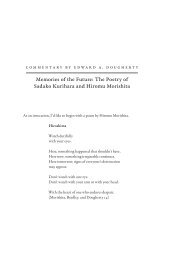Mark Dollar - War, Literature and the Arts
Mark Dollar - War, Literature and the Arts
Mark Dollar - War, Literature and the Arts
Create successful ePaper yourself
Turn your PDF publications into a flip-book with our unique Google optimized e-Paper software.
<strong>Mark</strong> <strong>Dollar</strong><br />
Ghost Imagery in <strong>the</strong> <strong>War</strong><br />
Poems of Siegfried Sassoon<br />
A<br />
Toronto newspaper once called Siegfried<br />
Sassoon, who was on a speaking tour of Canada<br />
in 1945, “ ‘an avenging angel through whom <strong>the</strong><br />
voice of slaughtered youth was speaking’ ” (qtd.<br />
in Sassoon, Siegfried’s Journey 297). Indeed, Sassoon did still speak on behalf of<br />
his peers who fought <strong>and</strong> died in <strong>the</strong> First World <strong>War</strong>, even though twenty-seven<br />
years had passed since <strong>the</strong> war ended. His ardent pacifism during <strong>the</strong> war<br />
led him to denounce Engl<strong>and</strong>’s continued involvement in a conflict he deemed<br />
unjust, <strong>and</strong> he saw those killed in battle as sacrificed unjustly. Their ghosts seem<br />
to have haunted Sassoon <strong>and</strong> caused him to regret mightily <strong>the</strong> cause of <strong>the</strong>ir<br />
deaths. In “Prelude: The Troops,” Sassoon imagines a horde of dead soldiers trudging<br />
off into eternity:<br />
O my brave brown companions, when your souls<br />
Flock silently away, <strong>and</strong> <strong>the</strong> eyeless dead<br />
Shame <strong>the</strong> wild beast of battle on <strong>the</strong> ridge,<br />
Death will st<strong>and</strong> grieving in that field of war<br />
Since your unvanquished hardihood is spent.<br />
And through some mooned Valhalla <strong>the</strong>re will pass<br />
Battalions <strong>and</strong> battalions scarred from hell.<br />
(Collected Poems 67)<br />
Sassoon conceives of <strong>the</strong>se ghosts as scarred, eyeless figures deformed by <strong>the</strong><br />
hell of battle; <strong>the</strong>y are supernatural figures of <strong>the</strong> macabre whom he pities for<br />
<strong>the</strong> loss of <strong>the</strong>ir youth. Ghosts appear frequently as images in his work on <strong>the</strong><br />
war, <strong>and</strong> <strong>the</strong>y tend to play three roles in <strong>the</strong> course of his poetry. Sassoon transforms<br />
his ghosts from heroic o<strong>the</strong>rs to pa<strong>the</strong>tic o<strong>the</strong>rs <strong>and</strong> finally into peers,<br />
provoking in him such emotions as admiration, pity, <strong>and</strong> empathy. The ghosts<br />
remind him of <strong>the</strong> war <strong>and</strong> make him feel guilty for having survived, prodding<br />
him to seek justification for <strong>the</strong>ir deaths. They remind him also of <strong>the</strong> importance<br />
of living worthily, ultimately becoming comforting friends.<br />
Sassoon did not expect <strong>the</strong> war to have such haunting effects when he arrived<br />
in France during November of 1915. Just before entering <strong>the</strong> trenches, he met<br />
WAR, LITERATURE & THE ARTS<br />
235
Robert Graves in <strong>the</strong> “C” Company mess of <strong>the</strong> First Battalion, Royal Welch<br />
Fusiliers. When Graves showed him a few pieces of his own war poetry, Sassoon<br />
objected to <strong>the</strong>ir harsh <strong>and</strong> realistic view of trench warfare; he thought he was<br />
familiar with <strong>the</strong> true face of war after four months of home training. Much of<br />
<strong>the</strong> poetry Sassoon wrote before he went into <strong>the</strong> trenches suggests that he was<br />
naïve about <strong>the</strong> war, that he thought dying in battle could actually benefit <strong>the</strong><br />
soldier. In “Absolution,” he writes:<br />
<strong>War</strong> is our scourge; yet war has made us wise,<br />
And, fighting for our freedom, we are free. . . .<br />
There was an hour when we were loth to part<br />
From life we longed to share no less than o<strong>the</strong>rs.<br />
Now, having claimed this heritage of heart,<br />
What need we more, my comrades <strong>and</strong> my bro<strong>the</strong>rs?<br />
(Collected Poems 11)<br />
Sassoon initially felt a great camaraderie with soldiers, many of whom were<br />
his subordinates, <strong>and</strong> understood death as a mystical force that could provide<br />
an ultimate bro<strong>the</strong>rhood. In his prose Memoirs of a Fox-Hunting Man (1928),<br />
Sassoon’s alter ego, George Sherston, feels very brave upon his arrival at boot<br />
camp in July of 1915, <strong>and</strong> he is completely credulous of war propag<strong>and</strong>a painting<br />
<strong>the</strong> enemy as evil incarnate (221) <strong>and</strong> portraying <strong>the</strong> English dead as “gloriously<br />
happy” in <strong>the</strong> afterlife (364). Of fighting, he finds “nothing imaginatively abhorrent<br />
in <strong>the</strong> notion,” <strong>and</strong> he feels “very much a man dedicated to death” (220). His<br />
dedication is to visiting death upon <strong>the</strong> enemy, not to dwelling on its inevitability<br />
at <strong>the</strong> Front. These impressions are formed, however, before Sherston experiences<br />
<strong>the</strong> Front for himself. Sassoon’s own ideals changed as <strong>the</strong> war came to a<br />
stalemate, <strong>and</strong> he was forced down into <strong>the</strong> trenches.<br />
By <strong>the</strong> early months of 1916, Sassoon began, he says, to write his first “genuine”<br />
trench poems (Siegfried’s Journey 25). Dying in battle became not a heroic<br />
act but a senseless waste to him. He became a staunch anti-war poet, concerned<br />
with giving an impersonal, au<strong>the</strong>ntic (“genuine”) description of conditions at<br />
<strong>the</strong> Front in order to inform readers back in Engl<strong>and</strong> of <strong>the</strong> less-than-honorable<br />
slaughter <strong>and</strong> to strip <strong>the</strong> euphemistic language away from <strong>the</strong> generals <strong>and</strong> propag<strong>and</strong>ists<br />
perpetuating <strong>the</strong> war. In his war poems, he tried to record his surroundings<br />
with detachment <strong>and</strong> create a whole new genre of poetry based on<br />
flat objectivity (26). Bernard Bergonzi claims that Sassoon’s poetry thus took on<br />
“a deliberate simplicity <strong>and</strong> hard outline that recalls <strong>the</strong> impact of good poster<br />
art” (97), of blunt anti-war propag<strong>and</strong>a.<br />
This poetry after 1916 generally tends to juxtapose <strong>the</strong> soldier’s daily boredom<br />
<strong>and</strong> discomforts with <strong>the</strong> madness of battle. Many of his poems rely upon<br />
236 WAR, LITERATURE & THE ARTS
anal images like barbed wire (“Trench Duty”), “crumps <strong>and</strong> lice <strong>and</strong> lack of<br />
rum” (“Suicide in <strong>the</strong> Trenches”), “sodden bags of chalk,” <strong>and</strong> “mounds of glimmering<br />
s<strong>and</strong>-bags, bleached with rain” (“A Working Party”) to counter any idea of<br />
<strong>the</strong> battlefield as a glorious place. Indeed, “A Working Party” is set during routine<br />
trench maintenance <strong>and</strong> begins with a crude detail: “Three hours ago he blundered<br />
up <strong>the</strong> trench, / Sliding <strong>and</strong> poising, groping with his boots.” The tedium<br />
of work, though, is not to be taken for granted in <strong>the</strong> trench, as <strong>the</strong> poem ends:<br />
He pushed ano<strong>the</strong>r bag along <strong>the</strong> top,<br />
Craning his body outward; <strong>the</strong>n a flare<br />
Gave one white glimpse of No Man’s L<strong>and</strong> <strong>and</strong> wire;<br />
And as he dropped his head <strong>the</strong> instant split<br />
His startled life with lead, <strong>and</strong> all went out.<br />
(Collected Poems 20)<br />
“A Working Party” relies on irony, <strong>the</strong> great disjunction between what one<br />
expects at <strong>the</strong> beginning of <strong>the</strong> work <strong>and</strong> what one gets by <strong>the</strong> end, to shock<br />
its reader. Yet both parts are presented in unsentimental detail, making use of<br />
<strong>the</strong> familiar, unremarkable objects of a trench; <strong>the</strong> poem’s realism suggests that<br />
such tragedies occur all <strong>the</strong> time for men at <strong>the</strong> Front. Dying at <strong>the</strong> Front, <strong>the</strong>n,<br />
is less heroic <strong>and</strong> transcendent than it is an absurd mistake. The drill sergeant<br />
in Sassoon’s “Conscripts,” for instance, asks his idealistic young charges “ ‘Magic?<br />
What’s magic got to do with you? / There’s no such thing! Blood’s red, <strong>and</strong> skies<br />
are blue,’ ” to disabuse <strong>the</strong>m of <strong>the</strong> notion that war is anything but real <strong>and</strong> ruthless<br />
(Collected Poems 31). To this day, most scholars focus on <strong>the</strong> hard, politically-charged<br />
realism of Sassoon’s work.<br />
While realism is a powerful method of protest in war poems, it none<strong>the</strong>less<br />
has its limitations for Sassoon. Jon Silkin argues that Sassoon is preeminently a<br />
visual poet; he first submits his intellect <strong>and</strong> his politics to <strong>the</strong> emotional force of<br />
whatever he perceives. After forming an impression of an experience, he attaches<br />
to it a didactic message or posits a social significance (167). Some memories,<br />
though, seem too horrible, too personal, for him to move past <strong>the</strong>ir emotional<br />
force. In much of his work, Sassoon revisits horrific war memories to contemplate<br />
<strong>the</strong>ir bizarre appeal, saying “Moments like those are unreproducible when<br />
I look back <strong>and</strong> try to recover <strong>the</strong>ir living texture. One’s mind eliminates boredom<br />
<strong>and</strong> physical discomfort, retaining an incomplete impression of a strange,<br />
intense, <strong>and</strong> unique experience” (“Infantry Officer” 311).<br />
The boring <strong>and</strong> uncomfortable realities hold less interest for Sassoon when<br />
<strong>the</strong>y divert him from <strong>the</strong> task of underst<strong>and</strong>ing a traumatic personal experience.<br />
For instance, when Sherston comes across a group of mangled soldiers in<br />
Memoirs of an Infantry Officer (1930), he remarks that, to him, unlike perhaps<br />
WAR, LITERATURE & THE ARTS 237
to o<strong>the</strong>rs who saw only its immediate irony or misfortune, <strong>the</strong> experience was<br />
particularly moving:<br />
I was doubtful whe<strong>the</strong>r <strong>the</strong>y were asleep or dead, for <strong>the</strong><br />
attitudes of many were like death, grotesque <strong>and</strong> distorted.<br />
But this is nothing new to write about, you will say;<br />
just a weary company, squeezing past dead or drowsing<br />
men while it sloshes <strong>and</strong> stumbles to a front-line trench.<br />
Never<strong>the</strong>less that night relief had its significance for me,<br />
though in human experience it had been multiplied a<br />
millionfold. (432)<br />
He remarks on <strong>the</strong> scene’s power to him personally <strong>and</strong> suggests that its<br />
macabre qualities will always haunt him. The scene is fantastic to him <strong>and</strong> thus<br />
is meaningful, more so than to o<strong>the</strong>rs who see it merely as harsh reality. The<br />
dead had <strong>the</strong> power to visit him in this fashion.<br />
In his poem “Sick Leave,” for example, he is visited by ghosts even when he is<br />
safe <strong>and</strong> away from <strong>the</strong> Front:<br />
When I’m asleep, dreaming <strong>and</strong> lulled <strong>and</strong> warm,—<br />
They come, <strong>the</strong> homeless ones, <strong>the</strong> noiseless dead.<br />
While <strong>the</strong> dim charging breakers of <strong>the</strong> storm<br />
Bellow <strong>and</strong> drone <strong>and</strong> rumble overhead,<br />
Out of <strong>the</strong> gloom <strong>the</strong>y ga<strong>the</strong>r about my bed.<br />
(Collected Poems 85)<br />
Many of Sassoon’s o<strong>the</strong>rworldly images emanated from such visions occurring<br />
after sleepless hours in grief <strong>and</strong> fear; <strong>the</strong>se “mysterious visualizations,” he<br />
says, come with “inventive spontaneity over which one has no seeming control”<br />
(Siegfried’s Journey 105). None<strong>the</strong>less, <strong>the</strong>se spectral visions tempted Sassoon<br />
with a “delusive sense of power to put <strong>the</strong>m into words,” to underst<strong>and</strong> <strong>the</strong>se<br />
memories by describing <strong>the</strong>m in poetic language (105). He mediates his discomfort<br />
by casting some of his memories as grotesques. He notes in Siegfried’s<br />
Journey (1945) that “somehow <strong>the</strong> workings of my mind brought me a comprehensive<br />
memory of war experience in its intense <strong>and</strong> essential humanity” (80).<br />
This comprehensive memory often takes <strong>the</strong> form of ghosts.<br />
Ghosts would become <strong>the</strong> chief image of death in Sassoon’s poetry both during<br />
<strong>and</strong> after <strong>the</strong> war. As supernatural figures of death, Sassoon’s ghosts embody<br />
his subjective feelings about <strong>the</strong> war. For Sassoon, as for many o<strong>the</strong>r artists from<br />
<strong>the</strong> Great <strong>War</strong>, returning ghosts served as powerful reminders of a cataclysmic<br />
experience, giving a not-so-physical presence to <strong>the</strong> “war-hauntedness” which<br />
238 WAR, LITERATURE & THE ARTS
afflicted so many veterans. The return of <strong>the</strong> dead was a popular <strong>the</strong>me in postwar<br />
Europe for veterans <strong>and</strong> civilians alike; traditional conceptions of <strong>the</strong> supernatural<br />
once again found <strong>the</strong>ir way into artistic consciousness <strong>and</strong> served as progenitors<br />
of bereavement <strong>and</strong> memory (Winter 223). Such a preoccupation was<br />
obvious in European cinema, poetry, fine art, <strong>and</strong> in popular culture as well. 1 That<br />
life continued post-mortem, that soldiers killed tragically could rise up in testament<br />
to life, was an important idea in much of <strong>the</strong> poetry written during <strong>and</strong><br />
after <strong>the</strong> war (221). Those who were most grief-stricken over <strong>the</strong> loss of loved<br />
ones often participated in séances where <strong>the</strong> deceased were summoned to make<br />
an account of how <strong>the</strong>y died (since such information was usually restricted by<br />
government censors) <strong>and</strong> how <strong>the</strong>y were getting on in eternity. 2<br />
Sassoon himself, though, seems not to have engaged in such communal hysteria.<br />
In fact, he once threatened Graves with a libel suit when Graves recounted<br />
in his memoirs a visit to Sassoon’s mo<strong>the</strong>r. Graves supposedly awakened in<br />
<strong>the</strong> night <strong>and</strong> heard Theresa Sassoon using spiritualist means to communicate<br />
with her dead son, Hamo (Graves 232). Siegfried judged his mo<strong>the</strong>r’s behavior<br />
as pa<strong>the</strong>tic <strong>and</strong> insane (Moeyes 172). However, Sassoon clearly saw nothing outl<strong>and</strong>ish<br />
in his own belief in ghosts. He was disinclined to go looking for <strong>the</strong> dead,<br />
since so often <strong>the</strong>y would come to him; he reports in Siegfried’s Journey that,<br />
at least during <strong>the</strong> war, “I was a believer in <strong>the</strong> power of spiritual presences”<br />
(81). Whe<strong>the</strong>r Sassoon believed in ghosts as having any thing o<strong>the</strong>r than a purely<br />
metaphoric character is immaterial, for, with Sassoon, <strong>the</strong> grotesque is a special<br />
figuration that takes on its existence in his writing. Wolfgang Kayser argues<br />
that ghosts function within <strong>the</strong> grotesque literary tradition as manifestations of<br />
insanity, as <strong>the</strong> link between <strong>the</strong> artist <strong>and</strong> <strong>the</strong> estranged world (184). Sassoon’s<br />
ghosts are only subtly estranged from <strong>the</strong> world of <strong>the</strong> living, which, for many in<br />
<strong>the</strong> Great <strong>War</strong>, was a world turned on end. His ghosts walk <strong>the</strong> terrain of recognizable<br />
l<strong>and</strong>scapes, yet <strong>the</strong>y are removed from normal time, often maimed, <strong>and</strong><br />
seem purposeful in <strong>the</strong>ir w<strong>and</strong>erings.<br />
In Sassoon’s poetry, one sees ghosts playing different roles at different times,<br />
whe<strong>the</strong>r <strong>the</strong>y are terrifying accusers during <strong>the</strong> war or beneficent friends in <strong>the</strong><br />
years after. Ghosts remind him of his duty to his fellow soldiers, <strong>and</strong> <strong>the</strong>y evoke<br />
emotions in him that belie <strong>the</strong> passionless detachment he so worked to attain in<br />
his descriptions of <strong>the</strong> war. For instance, in his entry for May 27, 1916, Sassoon<br />
laments <strong>the</strong> loss of one of his men; <strong>the</strong> boy died after a shell explodes, but, says<br />
Sassoon, “when I go out on patrols his ghost will surely be with me; he’ll catch<br />
his breath <strong>and</strong> grip his bomb just as he used to” (Diaries 1915-1918 68). The<br />
spectral presence of dead comrades (Hamo Sassoon was one) also pushes him to<br />
action, for, as he writes in “To My Bro<strong>the</strong>r,”<br />
WAR, LITERATURE & THE ARTS 239
Your lot is with <strong>the</strong> ghosts of soldiers dead,<br />
And I am in <strong>the</strong> field where men must fight.<br />
But in <strong>the</strong> gloom I see your laurell’d head<br />
And through your victory I shall win <strong>the</strong> light.<br />
(Collected Poems 11)<br />
Sassoon still holds in this poem to <strong>the</strong> promise of reward so palpable in<br />
“Absolution,” but he recounts in his diaries how he became truly enraged at <strong>the</strong><br />
Germans for killing his bro<strong>the</strong>r. Indeed, he was often called “Mad Jack” for his<br />
zeal in going over parapets. The war became personal to him. Sassoon could<br />
nei<strong>the</strong>r release his anger nor <strong>the</strong> memory of his beloved dead, for such memory<br />
“is <strong>the</strong> inevitable effect,” he says, “of death on <strong>the</strong> living, when <strong>the</strong> living have<br />
loved <strong>the</strong> dead” (Diaries 1920-1922 163). Very simply, lost comrades during <strong>the</strong><br />
war were not truly lost to him, only transformed into a different sort of soldier.<br />
Yet, in <strong>the</strong>ir transformation, Sassoon’s ghosts are separate from him. Their heroism<br />
comes in <strong>the</strong>ir demise, while he is left to fight on. At this point in his work,<br />
ghosts were different from him because <strong>the</strong>y died, heroically, in battle.<br />
At some stage, though, presumably when Sassoon was beginning to write “genuine”<br />
trench poems, <strong>the</strong> ghosts he envisioned became less heroic than pa<strong>the</strong>tic.<br />
In Sassoon’s eerie work “Enemies,” he describes a deceased comrade st<strong>and</strong>ing<br />
alone on <strong>the</strong> battlefield of Armageddon. Soon he is joined by o<strong>the</strong>r ghosts:<br />
. . . suddenly <strong>the</strong>re thronged<br />
Round him <strong>the</strong> hulking Germans that I shot<br />
When for his death my brooding rage was hot.<br />
He stared at <strong>the</strong>m, half-wondering; <strong>and</strong> <strong>the</strong>n<br />
They told him how I’d killed <strong>the</strong>m for his sake—<br />
Those patient, stupid, sullen ghosts of men . . . .<br />
(Collected Poems 26)<br />
The German ghosts blame <strong>the</strong> narrator for <strong>the</strong>ir slaughter, <strong>and</strong> his friend is<br />
left speechless to apologize for <strong>the</strong>ir deaths. The narrator, presumably Sassoon<br />
himself, st<strong>and</strong>s alone as a living man, <strong>and</strong> he must listen to <strong>the</strong>ir litany of complaints.<br />
His friend does not answer but merely smiles, <strong>and</strong> somehow <strong>the</strong> Germans<br />
underst<strong>and</strong>. The dead Germans are more tragic victims than foes, <strong>and</strong> <strong>the</strong> narrator’s<br />
comrade seems to join <strong>the</strong>m in <strong>the</strong>ir pained questioning of his friend. The<br />
ghosts in “Enemies” bear a resemblance to those in “Sick Leave,” who st<strong>and</strong> around<br />
Sassoon to “whisper” to his heart <strong>the</strong> question “Why are you here with all your<br />
watches ended? / From Ypres to Frise we sought you in <strong>the</strong> Line” (85). They are<br />
pa<strong>the</strong>tic because no answer could justify <strong>the</strong>ir deaths or bring <strong>the</strong>m back to life,<br />
but <strong>the</strong>y also accuse Sassoon for not dying with <strong>the</strong>m, as if he has betrayed <strong>the</strong>m.<br />
240 WAR, LITERATURE & THE ARTS
The ghosts who accuse Sassoon do so largely in protest of his survival. While<br />
convalescing in a hospital (<strong>the</strong> 4 th London) in April of 1917, Sassoon imagines<br />
a host of dead soldiers creeping across his floor. They are grotesque in <strong>the</strong>ir<br />
markedly livid faces, in <strong>the</strong>ir decomposing flesh which falls from <strong>the</strong>ir bones.<br />
Sassoon’s ghosts are not magical; <strong>the</strong>y do not fly about, move furniture, or cast<br />
spells. The only natural law <strong>the</strong>y seem to flout is that of <strong>the</strong> impossibility of reanimation.<br />
They are ra<strong>the</strong>r frozen, often in <strong>the</strong> moment just after death (hence<br />
<strong>the</strong>ir often mutilated features), as if <strong>the</strong>y were not dead but merely free to leave<br />
<strong>the</strong> war. The ghosts who come to him in <strong>the</strong> hospital glare at him in silence,<br />
but<br />
They are not here to scare me; <strong>the</strong>y look at me reproachfully,<br />
because I am so lucky, with my safe wound, <strong>and</strong><br />
<strong>the</strong> warm kindly immunity of <strong>the</strong> hospital is what <strong>the</strong>y<br />
longed for when <strong>the</strong>y shivered <strong>and</strong> waited for <strong>the</strong> attack<br />
to begin, or <strong>the</strong> brutal bombardment to cease. (Diaries<br />
1915-1918 161-62)<br />
That Sassoon marks in <strong>the</strong>m a reproachful glare suggests his own sense of<br />
guilt about ordering men to <strong>the</strong>ir deaths <strong>and</strong> for having survived <strong>the</strong> war, despite<br />
his early mad forays into No Man’s L<strong>and</strong>. As an officer who sent men into battle,<br />
Sassoon feels some complicity in <strong>the</strong>ir deaths. But <strong>the</strong>y <strong>and</strong> he were obeying<br />
orders; <strong>the</strong> men followed Sassoon’s <strong>and</strong> he followed his superiors’. By 1917,<br />
Sassoon fully distrusted <strong>the</strong> military authorities over him, writing in “A Soldier’s<br />
Declaration” that <strong>the</strong> war had become less about defense <strong>and</strong> liberation than<br />
aggression <strong>and</strong> conquest: “I can no longer be a party,” he says, “to prolong <strong>the</strong>se<br />
sufferings for ends which I believe to be evil <strong>and</strong> unjust . . . . On behalf of those<br />
who are suffering now I make this protest against <strong>the</strong> deception which is being<br />
practised on <strong>the</strong>m” (qtd. in Graves 260). His own guilt lessens as he protests <strong>the</strong><br />
war <strong>and</strong> seeks justice for his men.<br />
At some times <strong>the</strong>n, Sassoon feels great affinity for his ghosts, as if <strong>the</strong>y are<br />
fellow sufferers from <strong>the</strong> plague of war. The ghosts st<strong>and</strong> with him to accuse<br />
<strong>the</strong> powers that be of perpetuating <strong>the</strong> war, <strong>and</strong> <strong>the</strong>y become an inspiration to<br />
<strong>the</strong> prophetic figure Sassoon envisioned himself, <strong>the</strong> avenging angel. This sense<br />
of vengeance is strongest in <strong>the</strong> poem “On Passing <strong>the</strong> New Menin Gate.” As he<br />
strolls through a newly opened war cemetery in 1928, Sassoon resurrects <strong>the</strong><br />
dead with <strong>the</strong> power of his memory, saying<br />
Who will remember, passing through this Gate,<br />
The unheroic Dead who fed <strong>the</strong> guns?<br />
Who shall absolve <strong>the</strong> foulness of <strong>the</strong>ir fate,—<br />
WAR, LITERATURE & THE ARTS 241
Those doomed, conscripted, unvictorious ones?<br />
. . .<br />
Well might <strong>the</strong> Dead who struggled in <strong>the</strong> slime<br />
Rise <strong>and</strong> deride this sepulchre of crime.<br />
(Collected Poems 188)<br />
Sassoon sees it as his duty to remember <strong>the</strong>ir sacrifice <strong>and</strong> justify it, to make<br />
it meaningful by refusing to let a new generation forget <strong>the</strong>m. The souls who<br />
return to him attired in <strong>the</strong> gear of war serve as a focal point for his memory <strong>and</strong><br />
his duty: “It seemed,” he says, “that my companions of <strong>the</strong> Somme <strong>and</strong> Arras battles<br />
were around me; helmeted faces returned <strong>and</strong> receded in vision. . . . These<br />
were <strong>the</strong> dead, to whom life had been desirable, <strong>and</strong> whose sacrifice must be justified<br />
unless <strong>the</strong> war were to go down in history as yet ano<strong>the</strong>r Moloch of murdered<br />
youth” (Siegfried’s Journey 80). Even in death, <strong>the</strong>y are his companions,<br />
but justifying <strong>the</strong>ir deaths politically, by simply protesting <strong>the</strong> war, did not satisfy<br />
Sassoon. He still lived on <strong>and</strong> with his own traumas.<br />
Ultimately, Sassoon finds himself merely a substantial ghost, like <strong>the</strong> dead in<br />
his inexorable isolation from a more desirable world. To Sassoon, <strong>the</strong> more desirable<br />
world is one in which he is able to ride free on his horse, hunting foxes<br />
ra<strong>the</strong>r than men, <strong>and</strong> to live in peace as a gentleman-poet. In poems like “I Stood<br />
With <strong>the</strong> Dead” (“I stood with <strong>the</strong> Dead . . . They were dead; <strong>the</strong>y were dead; /<br />
My heart <strong>and</strong> my head beat a march of dismay” [Collected Poems 103]) his dismay<br />
over <strong>the</strong> war causes him ra<strong>the</strong>r to identify with ghosts. His sense of duty to<br />
<strong>the</strong>m prevents Sassoon from engaging fully in <strong>the</strong> world of <strong>the</strong> living.<br />
While stationed in Egypt in April of 1918, Sassoon imagined a concert party—<br />
women <strong>and</strong> men singing <strong>and</strong> dancing, oblivious to <strong>the</strong> horrors of <strong>the</strong> war. The<br />
scene becomes <strong>the</strong> focus of his poem “The Concert Party.” He reckons <strong>the</strong> partygoers<br />
mere puppets, masked fakeries who unwittingly entertain those who are<br />
truly real: a squad of deceased soldiers. They are pitiful in <strong>the</strong>ir separation from<br />
<strong>the</strong> lovelier world of <strong>the</strong> living; Sassoon describes <strong>the</strong>m thusly:<br />
This wall of faces risen out of <strong>the</strong> night,<br />
These eyes that keep <strong>the</strong>ir memories of places<br />
So long beyond <strong>the</strong>ir sight.<br />
(Collected Poems 100)<br />
His diary entry at <strong>the</strong> time he wrote <strong>the</strong> poem gives finer details about <strong>the</strong>se<br />
ghosts:<br />
In front [of <strong>the</strong> party-goers] <strong>the</strong>re are half-lit ruddy faces<br />
<strong>and</strong> glittering eyes, <strong>and</strong> behind <strong>the</strong>y grow more dusky<br />
242 WAR, LITERATURE & THE ARTS
<strong>and</strong> indistinct—-ghosts, souls of <strong>the</strong> dead—-<strong>the</strong> doomed—<br />
till on <strong>the</strong> edge high above <strong>the</strong> rest one sees silhouetted<br />
forms motionless, intent—those who were killed three<br />
years ago—<strong>and</strong> beyond <strong>the</strong>m, across <strong>the</strong> glimmering levels<br />
of s<strong>and</strong>, legions of o<strong>the</strong>rs come stealing in—-till <strong>the</strong><br />
crowd is limitless; all <strong>the</strong> dead have come to hear <strong>the</strong><br />
concert party in this half-lit oasis of Time. (Diaries 1915-<br />
1918 235)<br />
By <strong>the</strong> end of <strong>the</strong> poem, Sassoon has identified himself among <strong>the</strong> visiting<br />
dead, saying “We hear <strong>the</strong>m, drink <strong>the</strong>m; till <strong>the</strong> concert’s done,” but soon <strong>the</strong><br />
ghosts separate from him: “Silent, I watch <strong>the</strong> shadowy mass of soldiers st<strong>and</strong>. /<br />
Silent, <strong>the</strong>y drift away, over <strong>the</strong> glimmering s<strong>and</strong>” (Collected Poems 100). He has<br />
been left alone, nei<strong>the</strong>r a ghost nor a reveler. The bile raised in his throat upon<br />
contemplating <strong>the</strong> concert party indicates that, in essence, he identifies more<br />
with <strong>the</strong> soldier ghosts, though <strong>the</strong>y are insubstantial, timeless, <strong>and</strong> imagined,<br />
than with <strong>the</strong> living civilians: “It is too much,” he says, “I cannot bear it; I must<br />
get up <strong>and</strong> go away. For I too am a ghost, one of <strong>the</strong> doomed” (Diaries 1915-<br />
1918 235).<br />
Sassoon implies with such thoughts that he found himself isolated by his war<br />
life. He considered himself separated from people back home because of <strong>the</strong><br />
fundamental disjunction in <strong>the</strong>ir experiences. Even upon his return to Engl<strong>and</strong>,<br />
though he became a celebrated writer, he could not escape <strong>the</strong> public’s perception<br />
of him as a war poet. So too, of course, did he feel <strong>the</strong> sort of political isolation<br />
brought about by his unpopular declaration of 1917 <strong>and</strong> his resulting incarceration<br />
in Craiglockhart hospital. He also recognized <strong>the</strong> fundamental disparity<br />
between himself as an officer <strong>and</strong> his own living soldiers. Though Sassoon’s<br />
sense of connection with working-class men at <strong>the</strong> Front was remarkably solid,<br />
more so than at any o<strong>the</strong>r time in his life (Moeyes 68), he none<strong>the</strong>less acted as<br />
an observer, detached from <strong>the</strong> wistful hopes <strong>and</strong> frailties of o<strong>the</strong>r men. He only<br />
realizes a spiritual connection with <strong>the</strong>m once <strong>the</strong>y have died, when <strong>the</strong>y come<br />
to him as ghosts.<br />
In 1922, he would describe <strong>the</strong> living <strong>and</strong> <strong>the</strong> dead as equally inscrutable.<br />
However, he can at least hear <strong>the</strong> voices of <strong>the</strong> dead because <strong>the</strong>y have “a sort<br />
of silver quality,” or ra<strong>the</strong>r, a quality that is remarkable <strong>and</strong> priceless to him. How<br />
so? Because <strong>the</strong>y are products of his own making, wrought like silver out of his<br />
imagination. Thus <strong>the</strong> dead, Sassoon says, “are more real than <strong>the</strong> living, because<br />
<strong>the</strong>y are complete” (Diaries 1920-1922 231). This completeness—in essence<br />
<strong>the</strong> cessation of uncertainty—Sassoon found in his ghosts would become a quality<br />
he hoped to achieve as he became an old man. Many of his later years were<br />
spent in contemplation of <strong>the</strong> afterlife, <strong>and</strong> such speculation eventually led him<br />
WAR, LITERATURE & THE ARTS 243
to convert to Roman Catholicism in 1957. In 1953, he would write that he was<br />
“ ‘a fly buzzing against <strong>the</strong> window pane of ‘reality’ beyond which <strong>the</strong>re is <strong>the</strong><br />
world of <strong>the</strong> spiritual <strong>and</strong> <strong>the</strong> supernatural’ ” (qtd. in Moeyes 236). The only<br />
ones who can penetrate such a barrier are his ghosts, who finally come to him<br />
as memento mori. Sherston recalls that dead soldiers were like “mangled effigies”<br />
who warned <strong>the</strong> living of a fruitless existence (“Infantry Officer” 435). These<br />
ghosts, like Sassoon’s memories <strong>and</strong> hopes, are summoned <strong>and</strong> crafted by <strong>the</strong><br />
power of his mind.<br />
Upon remembrance of <strong>the</strong> dead, Sassoon underst<strong>and</strong>s <strong>the</strong> power of memory<br />
in summoning <strong>the</strong>ir presence. They are alive continually, <strong>and</strong> <strong>the</strong>y prod him<br />
to live a life set apart. In his diary entry of July 7, 1922, Sassoon determines that<br />
“Death is merely a reminder, to <strong>the</strong> living, of <strong>the</strong>ir duty toward life. It is a stimulus,”<br />
he says, “which should urge <strong>the</strong>m to fight on in that immortal war in which<br />
<strong>the</strong> spirit of man must be victorious over his grosser elements” (Diaries 1920-<br />
1922 191). Perhaps this is how <strong>the</strong> soldiers who died so unheroically in <strong>the</strong><br />
Great <strong>War</strong> are finally justified for Sassoon: <strong>the</strong>y assist him in justifying his own<br />
life, in giving him a sense of purpose in <strong>the</strong> aftermath of his own trauma.<br />
In 1919, just a year after <strong>the</strong> war ended, Sassoon published a collection of<br />
poems called Picture-Show. The poems deal with <strong>the</strong> war largely on a spiritual<br />
level, as <strong>the</strong>y were to be his proof to <strong>the</strong> literati that he could write poetry without<br />
gory or highly politicized references to <strong>the</strong> Front. The collection generated<br />
a mixed reception, however; he was seen by some to have lost <strong>the</strong> passion in his<br />
harshly realistic work. But <strong>the</strong> passion remains in <strong>the</strong> intimacy with his memories<br />
of <strong>the</strong> men who died around him. The title of <strong>the</strong> collection is a nod to <strong>the</strong><br />
burgeoning popularity of <strong>the</strong> cinema, <strong>the</strong> <strong>the</strong>n-silent medium which captured<br />
<strong>the</strong> “silver quality” of speechless forms on its silver screen. The screen serves as<br />
a metaphor for his recollection of <strong>the</strong> most powerful experiences he had in <strong>the</strong><br />
war, for it too features silent apparitions. In “Wraiths,” a work from Picture-Show,<br />
Sassoon serves as an apologist for <strong>the</strong> dead who haunt <strong>the</strong> living:<br />
Strangely <strong>the</strong>y seek a place<br />
In love’s night-memoried hall;<br />
Peering from face to face,<br />
Until some heart shall call<br />
And keep <strong>the</strong>m, for a breath,<br />
Half-mortal . . . (Hark to <strong>the</strong> rain!) . . .<br />
They are dead . . . (O hear how death<br />
Gropes on <strong>the</strong> shutter’d pane!)<br />
(Collected Poems 112)<br />
244 WAR, LITERATURE & THE ARTS
The ghosts merely seek someone to remember <strong>the</strong>m lovingly. Sassoon’s heart<br />
calls out to <strong>the</strong>m over <strong>and</strong> over again, <strong>and</strong> it is <strong>the</strong> only way he knows how to<br />
deal with <strong>the</strong> disconcerting experiences of <strong>the</strong> war—he must remember <strong>the</strong>m.<br />
He has not lost his passion about <strong>the</strong> senseless tragedy of <strong>the</strong> war; ra<strong>the</strong>r, he<br />
has focused that passion on <strong>the</strong> war’s most tragic personae—<strong>the</strong> ghosts of <strong>the</strong><br />
unjustly dead.<br />
Notes<br />
1. Take, for example, Abel Gance’s film J’Accuse (1919) <strong>and</strong> his remake of it (1937) that imagined<br />
<strong>the</strong> ghosts of dead soldiers rising from <strong>the</strong>ir graves to stop <strong>the</strong> spread of war. Also consider Irwin<br />
Shaw’s remarkable play Bury <strong>the</strong> Dead (1936), in which dead American soldiers refuse to be buried<br />
because <strong>the</strong>y died too young <strong>and</strong> for no real purpose.<br />
2. Winter notes how even such a well-regarded figure as Sir Arthur Conan Doyle attended séances<br />
<strong>and</strong> was fascinated by “spirit photography” (a practice based on <strong>the</strong> idea that a camera can capture<br />
a ghostly spirit on film) after <strong>the</strong> death of his son, Kingsley, from wounds received at <strong>the</strong> Somme<br />
(58).<br />
Works Cited<br />
Bergonzi, Bernard. Heroes’ Twilight: A Study of <strong>the</strong> <strong>Literature</strong> of <strong>the</strong> Great <strong>War</strong>. London: Constable,<br />
1965.<br />
Graves, Robert. Good-bye to All That. New York: Doubleday Anchor, 1957.<br />
J’Accuse. Dir. Abel Gance. Perf. Victor Francen, Jean-Max, Renee Devillers. Conoisseur, 1937.<br />
Kayser, Wolfgang. The Grotesque in Art <strong>and</strong> <strong>Literature</strong>. Trans. Ulrich Weisstein. Bloomington:<br />
Indiana UP, 1963.<br />
Moeyes, Paul. Siegfried Sassoon: Scorched Glory. New York: St. Martin’s,1997.<br />
Sassoon, Siegfried. Collected Poems: 1908-1956. London: Faber <strong>and</strong> Faber, 1984.<br />
—. Diaries 1914-1918. Ed. Rupert Hart-Davis. London: Faber <strong>and</strong> Faber, 1983.<br />
—. Diaries 1920-1922. Ed. Rupert Hart-Davis. London: Faber <strong>and</strong> Faber, 1981.<br />
—. “Memoirs of a Fox-Hunting Man.” The Complete Memoirs of George Sherston. London: Faber<br />
<strong>and</strong> Faber, 1986. 1-282.<br />
—. “Memoirs of an Infantry Officer.” The Complete Memoirs of George Sherston. London: Faber<br />
<strong>and</strong> Faber, 1986. 285-514.<br />
—. Siegfried’s Journey. New York: Viking, 1946.<br />
Shaw, Irwin. Bury <strong>the</strong> Dead. New York: R<strong>and</strong>om House, 1936.<br />
Silkin, Jon. Out of Battle: The Poetry of <strong>the</strong> Great <strong>War</strong>. New York: Ark, 1987.<br />
Winter, Jay. Sites of Memory, Sites of Mourning: The Great <strong>War</strong> in European Cultural History.<br />
Cambridge: Cambridge UP, 1995.<br />
<strong>Mark</strong> <strong>Dollar</strong> holds a Ph.D. in British <strong>Literature</strong> from Purdue University <strong>and</strong> is an assistant professor<br />
at King College in Bristol, Tennessee. This essay comes from a book he is working on titled The<br />
Grotesque <strong>War</strong>: British Poetry of World <strong>War</strong> I.<br />
WAR, LITERATURE & THE ARTS 245


